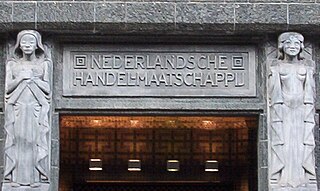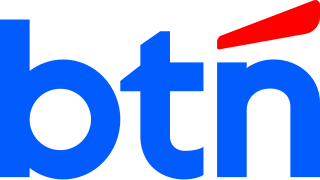
Indian Bank is an Indian public sector bank, established in 1907 and headquartered in Chennai. It serves over 100 million customers with 41,645 employees, 5,814 branches with 4,929 ATMs and Cash deposit machines. Total business of the bank has touched ₹1,094,752 crore (US$140 billion) as onfMarch 231, 023.

The Nederlandsch-Indische Handelsbank was a Dutch bank established in 1863 to finance trade between the Netherlands and the Dutch East Indies. During most of the colonial period, it was the second-largest of the “big three” commercial banks, behind the Netherlands Trading Company and ahead of the Nederlandsch-Indische Escompto Maatschappij, that dominated the Dutch East Indies’ financial system alongside the note-issuing Bank of Java.

The Netherlands Trading Society was a Dutch trading and financial company, established in 1824, in The Hague by King William I to promote and develop trade, shipping and agriculture. For the next 140 years the NHM developed a large international branch network and increasingly engaged in banking operations. In 1964, it merged with Twentsche Bank to form Algemene Bank Nederland, itself a predecessor of ABN AMRO.
The Chartered Bank of India, Australia and China was a bank incorporated in London in 1853 by Scotsman James Wilson, under a Royal Charter from Queen Victoria.
The Salim Group is Indonesia's biggest conglomerate and refers to companies where the Salim family held majority ownership. Its assets include Indofood Sukses Makmur, the world's largest instant noodle producer; Indomobil Group, one of Indonesia's largest car manufacturers; Indomaret, Indonesia's largest convenience store chain; and Bogasari, a large flour-milling operation. The group was founded in October 1972 by Sudono Salim and his junior partner Sutanto Djuhar. The current CEO is Anthoni Salim, a son of Sudono Salim.

PRIMA is one of the interbank networks in Indonesia. PRIMA is owned by PT Rintis Sejahtera. PT Rintis Sejahtera is a Satellite Communication services provider that transmitting digital information within the region and around the world. Before the creation of ATM PRIMA, this network was known as ATM BCA network that worked as the ATM network for Bank Central Asia.
Public Sector Undertakings (Banks) are a major type of government-owned banks in India, where a majority stake (i.e., more than 50%) is held by the Ministry of Finance (India) of the Government of India or State Ministry of Finance of various State Governments of India. The shares of these government-owned-banks are listed on stock exchanges. Their main objective is social welfare.

The Ministry of Health is a government ministry which organize public health affairs within the Indonesian government.

Jalan M.H. Thamrin or Jalan Thamrin is a major thoroughfare in Jakarta, Indonesia. The road is located at the center of Jakarta, running from the north end of Jalan Jenderal Sudirman at West Flood Canal at the south end to the roundabout near Arjuna Wijaya Statue Jakarta at the north end. Developed in the 1950s, the road was a landmark of post-colonial Indonesia and continues to have a prominent importance in Jakarta.

Mandiri Museum, or Bank Mandiri Museum, is the corporate museum of the namesake Bank Mandiri, located in the old banking district of Jakarta Old Town in northern Jakarta, Indonesia. The museum is housed in the former headquarters of the Netherlands Trading Society, one of the primary ancestor of ABN AMRO. The museum is closed on Mondays and public holidays. It is located next to Museum Bank Indonesia, and right in front of Jakarta Kota Station.

PT Bank Tabungan Negara (Persero) Tbk, lit. "National (State) Savings Bank", abbreviated and trading as BTN, is an Indonesian commercial bank best known as a mortgage bank, headquartered in Gambir, Jakarta.
In Indonesia, state-owned enterprises play an important role in the national economy. Their roles includes contributor for national economy growth, providing goods or services which are not covered by private company, employment provider, providing support guidance to small and medium businesses, and source of government revenue. The Ministry of State Owned Enterprises represents the government's function as a shareholder of most of those companies, while some are represented by the Ministry of Finance.
Rachmat Muljomiseno, also known by his alias Tjuk, was an Indonesian politician who served as a member of the People's Representative Council from 1971 until 1982. Previously, he served as Minister of Trade from 1958 until 1959, Director of Bank Negara Indonesia from 1957 until 1958, and was a military officer who fought in the Indonesian National Revolution attaining the rank of major.

The National Civil Service Agency is a non-ministry government body in Indonesia for civil servant management. The equivalent counterpart are Civil Service in United Kingdom.

Raden Mas Margono Djojohadikusumo was an Indonesian politician and banker. He was the founder and the first president of Bank Negara Indonesia, and was also a member of the Investigating Committee for Preparatory Work for Independence.

The Nederlandsch-Indische Escompto Maatschappij was a significant Dutch bank, founded in 1857 in Batavia, Dutch East Indies. In the first half of the 20th century, it was the smallest of the “big three” commercial banks, behind the Netherlands Trading Society and the Nederlandsch-Indische Handelsbank, that dominated the Dutch East Indies’ financial system alongside the note-issuing Bank of Java.















